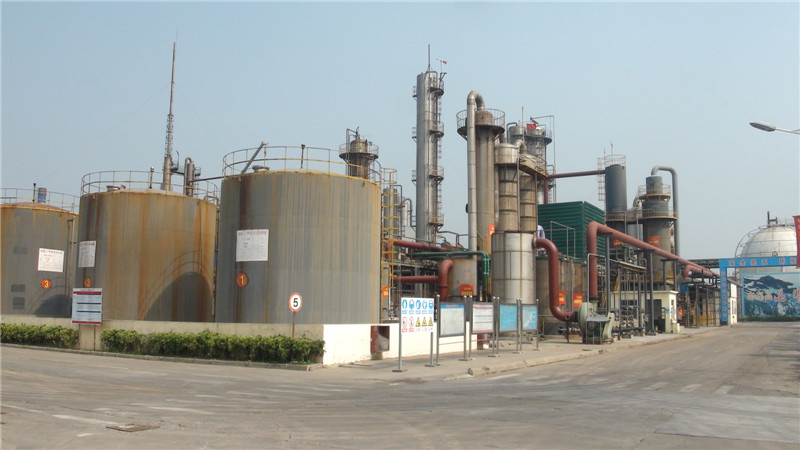Dimethyl Sulfate(DMS)CAS 77-78-1 Uses
Dimethyl sulfate is a versatile methylating agent extensively used in organic synthesis across industries, including pesticides, dyes, pharmaceuticals, and fragrances. It’s primarily employed to produce methyl esters, methyl ethers, and methylamines, and it serves as a raw material for compounds like dimethyl sulfoxide, caffeine, codeine, amidopyrine, trimethoprim, vanillin, and the pesticide methamidophos. Additionally, it functions as a solvent for aromatic hydrocarbons and as an alkylating agent.
Applications as a Methylating Reagent and Solvent
Dimethyl sulfate serves as a methylating reagent and solvent in the production of medicines, pesticides, dyes, and fragrances.
Uses in Dye Production and Methylation
Dimethyl sulfate is utilized in dye production and acts as a methylating agent for amines and alcohols.
Dimethyl Sulfate – Applications
Dimethyl sulfate is primarily employed in the methylation of phenols, amines, and thiols, typically via an SN2 mechanism. Although these alkylation reactions are efficient and dimethyl sulfate is cost-effective, its high toxicity limits its use. Comparatively:
- Methyl iodide is less toxic but more expensive and is better suited for O-methylation.
- Dimethyl carbonate is less toxic and can be used for N-methylation.
When selecting a methylating agent, it’s essential to balance toxicity and reaction effectiveness.
Dimethyl sulfate also serves as a reagent for determining coal tar components, as a methyl substitute in organic synthesis, and as a solvent for aromatic hydrocarbons.
Specific Methylation Reactions
O-Methylation
O-Methylation of phenols is a common application, which can also apply to simple alcohols. For instance:
2(CH3)3COH+(CH3O)2SO2→2(CH3)3COCH3+H2SO42(CH_3)_3COH + (CH_3O)_2SO_2 \rightarrow 2(CH_3)_3COCH_3 + H_2SO_42(CH3)3COH+(CH3O)2SO2→2(CH3)3COCH3+H2SO4
Similarly, alkoxides can be methylated:
RO−Na++(CH3O)2SO2→ROCH3+Na(CH3)SO4RO^- Na^+ + (CH_3O)_2SO_2 \rightarrow ROCH_3 + Na(CH_3)SO_4RO−Na++(CH3O)2SO2→ROCH3+Na(CH3)SO4
The O-methylation of carbohydrates using dimethyl sulfate forms the basis of the Haworth method for determining cyclic sugar structures, typically performed in alkaline solutions. An alternative method involves methyl iodide with silver oxide.
N-Methylation
Dimethyl sulfate methylates amines, producing quaternary ammonium salts or tertiary amines. For example:
C6H5CH=NC4C9+(CH3O)2SO2→C6H5CH=N+(CH3)C4C9+CH3OSO3−C_6H_5CH=NC_4C_9 + (CH_3O)_2SO_2 \rightarrow C_6H_5CH=N^+(CH_3)C_4C_9 + CH_3OSO_3^-C6H5CH=NC4C9+(CH3O)2SO2→C6H5CH=N+(CH3)C4C9+CH3OSO3−
Aliphatic quaternary ammonium salts derived from this reaction may act as surfactants or fabric softeners. In the reaction with tertiary amines:
p−CH3(C6H4)NH2+(CH3O)2SO2→p−CH3(C6H4)N(CH3)2+Na(CH3)SO4p-CH_3(C_6H_4)NH_2 + (CH_3O)_2SO_2 \rightarrow p-CH_3(C_6H_4)N(CH_3)_2 + Na(CH_3)SO_4p−CH3(C6H4)NH2+(CH3O)2SO2→p−CH3(C6H4)N(CH3)2+Na(CH3)SO4
S-Methylation
Dimethyl sulfate can also methylate thiolates, where sulfur is methylated:
RS−Na++(CH3O)2SO2→RSCH3+Na(CH3)SO4RS^- Na^+ + (CH_3O)_2SO_2 \rightarrow RSCH_3 + Na(CH_3)SO_4RS−Na++(CH3O)2SO2→RSCH3+Na(CH3)SO4
For example, with thioesters:
RC(O)SH+(CH3O)2SO2→RC(O)S(CH3)+HOSO3CH3RC(O)SH + (CH_3O)_2SO_2 \rightarrow RC(O)S(CH_3) + HOSO_3CH_3RC(O)SH+(CH3O)2SO2→RC(O)S(CH3)+HOSO3CH3
Additional Applications
Dimethyl sulfate methylates the N7 position of guanine in DNA, weakening the glycosidic bond with ribose. Under alkaline conditions, piperidine treatment results in phosphodiester bond cleavage, fragmenting DNA. This technique is used to determine base sequences and break DNA strands selectively.
Under acidic conditions, dimethyl sulfate methylates both the N7 of guanine and the N3 of adenine in DNA, producing a selective reaction for purine bases.
Production Method of Dimethyl Sulfate
Dimethyl sulfate is synthesized by various methods, but industrial production primarily uses the reaction of dimethyl ether and sulfur trioxide:
- Methanol is dehydrated to produce dimethyl ether.
- Sulfur trioxide gas is generated from heated 25% fuming sulfuric acid and absorbed by spraying dimethyl sulfate.
- The sulfur trioxide-laden dimethyl sulfate then reacts with dimethyl ether in a synthesis tower to form dimethyl sulfate. The product has a purity of ≥98%, with the following raw material consumption:
- Methanol: 550 kg/t
- Fuming sulfuric acid (25%): 3000 kg/t
The process involves:
- Adding fuming sulfuric acid into an evaporation tank and heating.
- Generating sulfur trioxide, which is then transferred to an esterification tank.
- Converting methanol to dimethyl ether and washing with sulfuric acid to remove moisture.
- Finally, sulfur trioxide reacts with dimethyl ether in the esterification tank, yielding crude dimethyl sulfate, which is then refined.
Alternate Method
An alternate method involves methanol reacting with sulfuric acid to produce methyl hydrogen sulfate, which then continues to react with methanol to produce dimethyl ether. This ether interacts with sulfur trioxide to form dimethyl sulfate.

